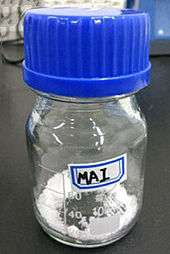Methylammonium halide
Methylammonium halides are organic halides with a formula of CH3NH3X, where X is Cl, Br or I. Generally they are white or light colored powders. They are used primarily to prepare light absorbing semiconductors for perovskite solar cells.
Compounds
| |||
| Names | |||
|---|---|---|---|
| IUPAC name
Methylazanium bromide | |||
| Systematic IUPAC name
Methanaminium bromide | |||
Other names
| |||
| Identifiers | |||
3D model (JSmol) |
|||
| ChemSpider | |||
| EC Number |
| ||
PubChem CID |
|||
| |||
| |||
| Properties | |||
| CH3NH3Br | |||
| Molar mass | 111.96904 g/mol | ||
| Melting point | 296[1] °C (565 °F; 569 K) | ||
| Hazards | |||
| Main hazards | irritant | ||
Except where otherwise noted, data are given for materials in their standard state (at 25 °C [77 °F], 100 kPa). | |||
| Infobox references | |||
| |||
| Names | |||
|---|---|---|---|
| IUPAC name
Methylazanium chloride | |||
| Systematic IUPAC name
Methanaminium chloride | |||
Other names
| |||
| Identifiers | |||
3D model (JSmol) |
|||
| ChemSpider | |||
| EC Number |
| ||
PubChem CID |
|||
| |||
| |||
| Properties | |||
| CH3NH3Cl | |||
| Molar mass | 67.51804 g/mol | ||
| Appearance | Colorless crystals | ||
| Hazards | |||
| Main hazards | irritant | ||
Except where otherwise noted, data are given for materials in their standard state (at 25 °C [77 °F], 100 kPa). | |||
| Infobox references | |||
| |||
| Names | |||
|---|---|---|---|
| IUPAC name
Methylazanium iodide | |||
| Systematic IUPAC name
Methanaminium iodide | |||
Other names
| |||
| Identifiers | |||
3D model (JSmol) |
|||
| ChemSpider | |||
| EC Number |
| ||
PubChem CID |
|||
| |||
| |||
| Properties | |||
| CH3NH3I | |||
| Molar mass | 158.96951 g/mol | ||
| Appearance | White powder [2] | ||
Except where otherwise noted, data are given for materials in their standard state (at 25 °C [77 °F], 100 kPa). | |||
| Infobox references | |||
Applications

The primary application for these compounds is as a component of perovskite (structure) crystalline solar cells.[3] The iodide is the most commonly used. When complexed with other metallic iodides such as tin iodide or lead iodide it can be used as a light gathering compound in place of naturally occurring organic dyes, providing excellent bandgap and charge mobility. Other methylammonium halides such as the chloride and bromide can be used instead of, or as minor substituents to, methylammonium iodide, providing the ability to tune the absorption, conductivity, and apparent bandgap. Magnetic ion doping like manganese results in a magnetic photoconductive material which opens avenues for magneto-optical data storage based on this material.[4]
Production
These compounds are usually prepared by combining equimolar amounts of methylamine with the appropriate halide acid. For instance methylammonium iodide is prepared by combining methylamine and hydrogen iodide at 0 °C for 120 minutes followed by evaporation at 60 °C, yielding crystals of methylammonium iodide.[5]
- CH3NH2 + HI → CH3NH3I
Crystallography
These compounds' crystallography has been the subject of much investigation. J.S. Hendricks published an early paper on them in 1928.[6] Methylammonium chloride was investigated again in 1946[7] and methylammonium bromide in 1961.[8]
See also
- Methylamine
- Onium compound
- Methylammonium lead halide
References
- "Sigma-Aldrich". Sigma-Aldrich. Retrieved 5 February 2017.
- "Methylammonium Iodide". Greatcell Solar Materials. Retrieved 15 May 2020.
- Li, Hangqian. (2016). "A modified sequential deposition method for fabrication of perovskite solar cells". Solar Energy. 126: 243–251. doi:10.1016/j.solener.2015.12.045.
- Náfrádi, Bálint (24 November 2016). "Optically switched magnetism in photovoltaic perovskite CH3NH3(Mn:Pb)I3". Nature Communications. 7: 13406. arXiv:1611.08205. doi:10.1038/ncomms13406. PMC 5123013. PMID 27882917.
- Qiu, Jianhang; Qiu, Yongcai; Yan, Keyou; Zhong, Min; Mu, Cheng; Yan, He; Yang, Shihe (2013), "All-solid-state hybrid solar cells based on a new organometal halide perovskite sensitizer and one-dimensional TiO2 nanowire arrays", Nanoscale, 5 (8): 3245–3248, doi:10.1039/C3NR00218G, PMID 23508213
- Hendricks, J.S. (1928), "The crystal structures of the monomethyl ammonium halides", Z. Kristallogr., 67 (1): 106–118, doi:10.1524/zkri.1928.67.1.106
- Hughes, Edward W.; Lipscomb, William N. (1946), "The Crystal Structure of Methylammonium Chloride", J. Am. Chem. Soc., 68 (10): 1970–1975, doi:10.1021/ja01214a029
- Gabe, E.J. (1961), "The crystal structure of methylammonium bromide", Acta Crystallogr., 14 (12): 1296, doi:10.1107/S0365110X6100382X
